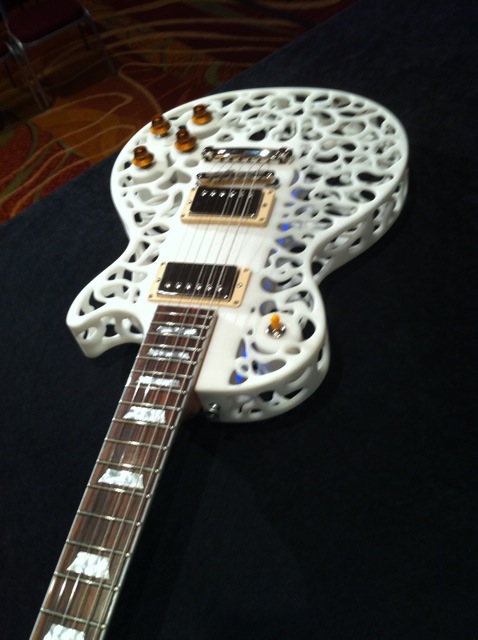It’s hard for a keynote at SPAR to please everyone. The great thing about SPAR is that it attracts just about every type of person who has an interest in 3D data capture. And that’s the hard, thing, too. How do you find a speaker who appeals both to a chief of forensics and an architect, a surveyor and a video game developer? I certainly don’t envy conference programmer Linda McLaughlin her job, but she knocked it out of the park this year, I’ll say that.
First up was Dr. Phil Manning, aka the Dino CSI guy for his work with the National Geographic channel showing people how he goes about using technology to uncover the distant past and make discoveries that inform the way we’ll go about our future. I interviewed him a few weeks back, so I was fairly confident his enthusiasm and plain charisma would win the day, but, really, are these engineers going to care about laser scanning dinosaur bones?
Apparently. They ate the guy up. First, it wouldn’t surprise me if this crowd weren’t also the crowd (like some of my five-year-old son’s contemporaries) who could name 100 dinosaurs on sight when they were kids and spent half their childhood in the Natural History Museum. That’s the kind of mind that SPAR attracts.
But he also told the crowd things they didn’t know. The synchrotron? Yeah, I’d never heard of one before I interviewed him, either.
I loved how, at the end, Manning said, “have any ideas? I’ve got some time with the synchrotron next month.” Being at SPAR makes it possible you could slam electrons into things if you wanted to. That’s a pretty good selling point, marketing folks. Keep that in mind.
Next up, Abe Reichental, CEO of 3D Systems, blew some minds as well. It certainly didn’t hurt that his rivals had teamed to form a $1.4 billion competitor that same morning (maybe there’s something to this 3D printing after all, eh?), but I think the clincher was pretty much the 3D printer he plugged in at the beginning of the session and proceeded to actual print out a chess rook as the speakers took the stage. There it sat, humming away, until it finished just as he was finishing his talk about the impact that 3D printing would have on democratizing access to design and the 3D environment.
And the printer costs $1,200. Yeah, I knew about Cubify, but apparently some of you haven’t been reading your SPARView, judging by the jaws on the floor. But even knowing about Cubify, seeing something like this rook in the flesh is pretty illuminating:

Yes, I did ask to have it. That’s the kind of allure these 3D printed objects have. I also wanted the 3D printed guitar that Reichental brought and allowed me to play from the stage. I wanted it badly (that’s partly because it’s a full featured Les Paul, and the body could have been made from dried moose poop and the hardware would still have made it pretty sweet, but that’s another matter). I believe that Eric Clapton and Slash want it badly, too.
As I said from the stage, tack the Geomagic buy of Sensable together and imagine a world where guitarists take a basic guitar body model, sculpt it digitally with their hands, and then print out exactly what they want before bolting on the neck and hardware. Brilliant.
This is what it looked like. Lots of people crowded around and asked if the body design was to keep it light, etc., and it did feel light, but not too light, but I think it’s just basically supposed to look cool. The body could have been made out of anything. You can’t see it, but there are blue LEDs in the middle of the body that light up when you play, actually:

Finally, there was Lawrie Jordan, head of imaging at ESRI. You can read the write-up of what he had to say here, but most important was that he acknowledged that ESRI isn’t all the way to incorporating every bit of 3D data in the perfect way yet, but that they see the future and they’re heading for it.
Again, he returned to the idea of democratizing 3D data capture. Crowd-sourced capture, cheap access to software through the cloud on demand, being able to find maps and data that someone has already worked on and building off that work rather than starting from scratch all the time.
I love the idea of making GIS a collaborative approach. Why should there be more than one map of any city? Why not just have on map online that everyone is constantly filling in with more information and data? Well, because people are trying to make a business out of that idea, I guess, but there’s certainly no reason for FEMA and the City of Boston to both have emergency preparedness maps of the city. They should definitely be working from the same document. Now that’s getting much more possible to make happen.
So, what’s the common theme here? I think the common theme is that only a complete and total generalist, who spent all day surfing the internet and never actually worked on an actual job, could have sat in those three keynote addresses and not learned something. Isn’t that what we should all be trying to do when we go to these conferences? Learn something? Get smarter? Steal ideas? Be inspired (whoops, sorry, that’s Bentley’s line…)?
That’s what happened for me on Monday. That’s what happened to Ian Grant, survey manager at L&S Surveying. Grant is based in Trinidad & Tobago, and I just thought his reaction to the keynotes encapsulated so much of the reaction I heard from just about everyone on site:
Good stuff.





